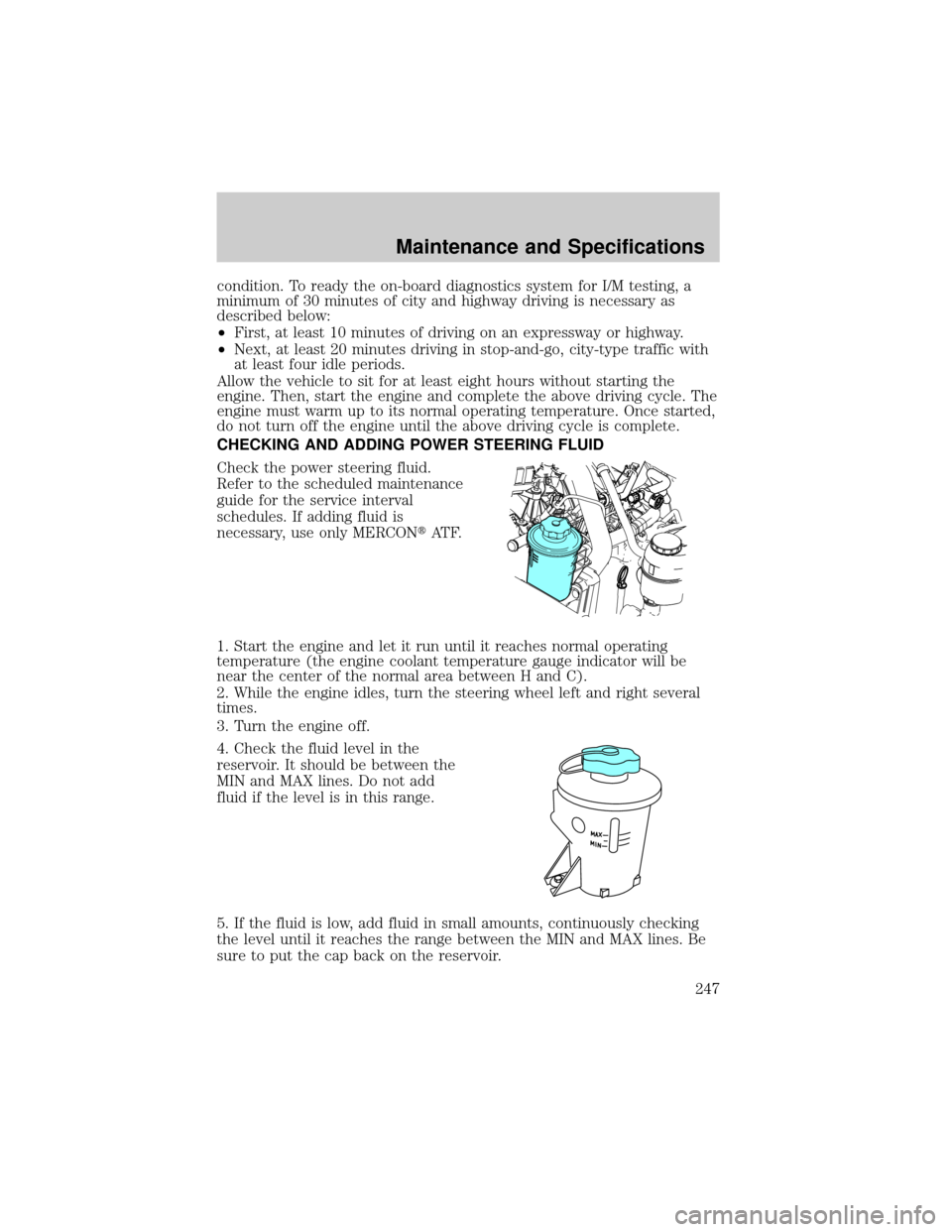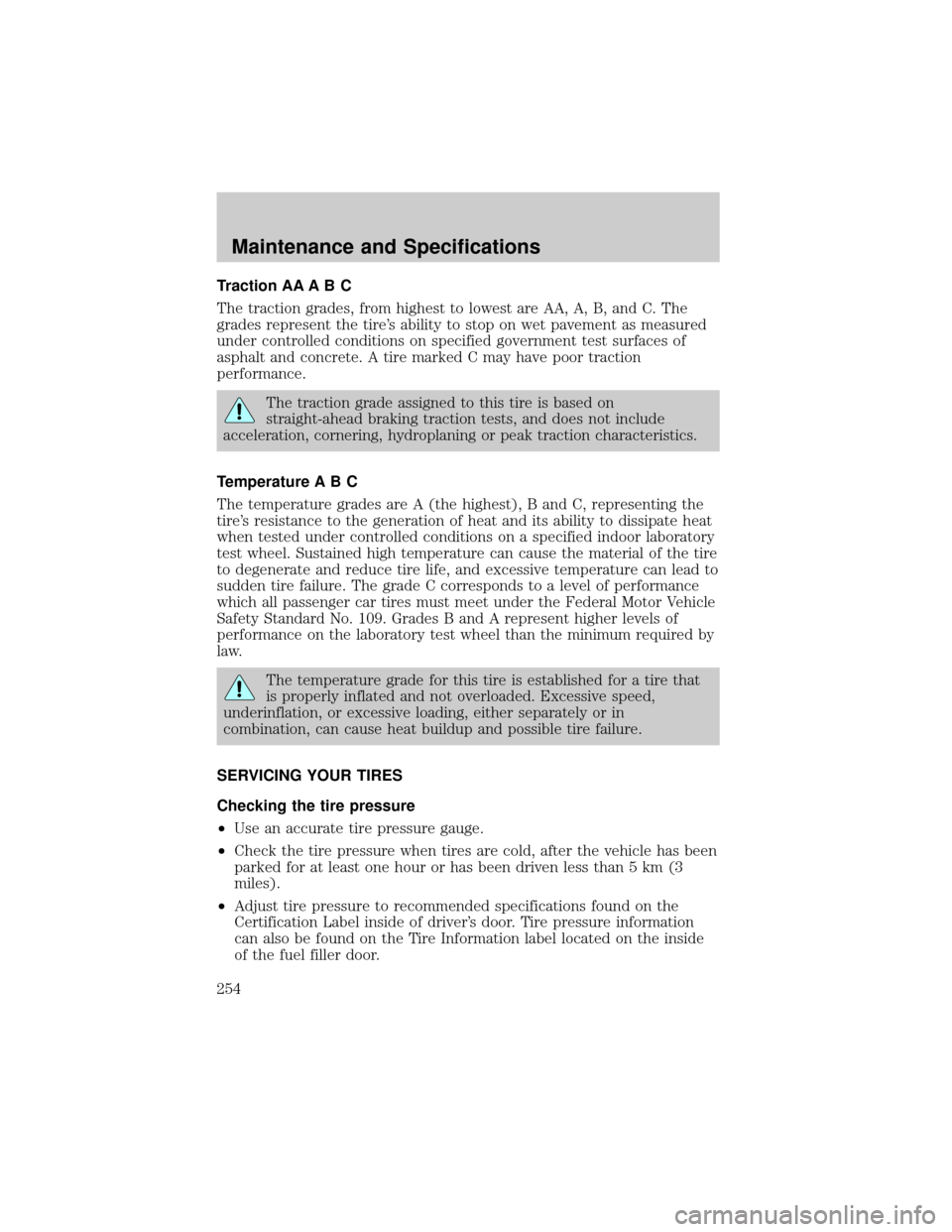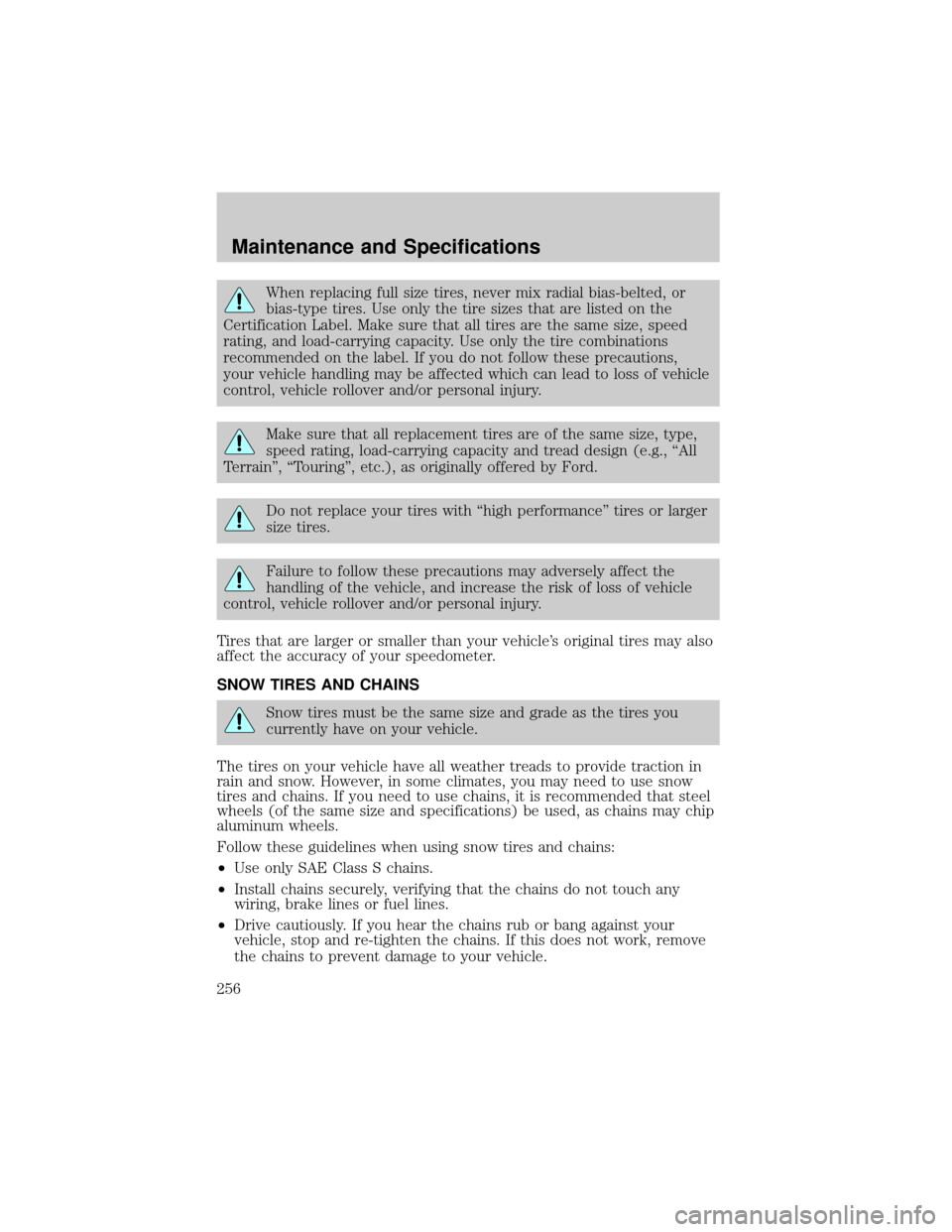Page 247 of 280

condition. To ready the on-board diagnostics system for I/M testing, a
minimum of 30 minutes of city and highway driving is necessary as
described below:
²First, at least 10 minutes of driving on an expressway or highway.
²Next, at least 20 minutes driving in stop-and-go, city-type traffic with
at least four idle periods.
Allow the vehicle to sit for at least eight hours without starting the
engine. Then, start the engine and complete the above driving cycle. The
engine must warm up to its normal operating temperature. Once started,
do not turn off the engine until the above driving cycle is complete.
CHECKING AND ADDING POWER STEERING FLUID
Check the power steering fluid.
Refer to the scheduled maintenance
guide for the service interval
schedules. If adding fluid is
necessary, use only MERCONtAT F.
1. Start the engine and let it run until it reaches normal operating
temperature (the engine coolant temperature gauge indicator will be
near the center of the normal area between H and C).
2. While the engine idles, turn the steering wheel left and right several
times.
3. Turn the engine off.
4. Check the fluid level in the
reservoir. It should be between the
MIN and MAX lines. Do not add
fluid if the level is in this range.
5. If the fluid is low, add fluid in small amounts, continuously checking
the level until it reaches the range between the MIN and MAX lines. Be
sure to put the cap back on the reservoir.
Maintenance and Specifications
247
Page 254 of 280

Traction AA A B C
The traction grades, from highest to lowest are AA, A, B, and C. The
grades represent the tire's ability to stop on wet pavement as measured
under controlled conditions on specified government test surfaces of
asphalt and concrete. A tire marked C may have poor traction
performance.
The traction grade assigned to this tire is based on
straight-ahead braking traction tests, and does not include
acceleration, cornering, hydroplaning or peak traction characteristics.
Temperature A B C
The temperature grades are A (the highest), B and C, representing the
tire's resistance to the generation of heat and its ability to dissipate heat
when tested under controlled conditions on a specified indoor laboratory
test wheel. Sustained high temperature can cause the material of the tire
to degenerate and reduce tire life, and excessive temperature can lead to
sudden tire failure. The grade C corresponds to a level of performance
which all passenger car tires must meet under the Federal Motor Vehicle
Safety Standard No. 109. Grades B and A represent higher levels of
performance on the laboratory test wheel than the minimum required by
law.
The temperature grade for this tire is established for a tire that
is properly inflated and not overloaded. Excessive speed,
underinflation, or excessive loading, either separately or in
combination, can cause heat buildup and possible tire failure.
SERVICING YOUR TIRES
Checking the tire pressure
²Use an accurate tire pressure gauge.
²Check the tire pressure when tires are cold, after the vehicle has been
parked for at least one hour or has been driven less than 5 km (3
miles).
²Adjust tire pressure to recommended specifications found on the
Certification Label inside of driver's door. Tire pressure information
can also be found on the Tire Information label located on the inside
of the fuel filler door.
Maintenance and Specifications
254
Page 255 of 280
Improperly inflated tires can affect vehicle handling and can fail
suddenly, possibly resulting in loss of vehicle control, vehicle
rollover and/or personal injury.
Tire rotation
Because your vehicle's tires perform different jobs, they often wear
differently. To make sure your tires wear evenly and last longer, rotate
them as indicated in the scheduled maintenance guide. If you notice that
the tires wear unevenly, have them checked.
The following procedure applies to vehicles equipped with single rear
wheels, if your vehicle is equipped with dual rear wheels it is
recommended that only the front wheels be rotated (side to side).
²Four tire rotation
Replacing the tires
Replace the tires when the wear
band is visible through the tire
treads. Due to exposure to the
elements and exhaust you should
replace the spare tire when you
replace the other tires.
Maintenance and Specifications
255
Page 256 of 280

When replacing full size tires, never mix radial bias-belted, or
bias-type tires. Use only the tire sizes that are listed on the
Certification Label. Make sure that all tires are the same size, speed
rating, and load-carrying capacity. Use only the tire combinations
recommended on the label. If you do not follow these precautions,
your vehicle handling may be affected which can lead to loss of vehicle
control, vehicle rollover and/or personal injury.
Make sure that all replacement tires are of the same size, type,
speed rating, load-carrying capacity and tread design (e.g., ªAll
Terrainº, ªTouringº, etc.), as originally offered by Ford.
Do not replace your tires with ªhigh performanceº tires or larger
size tires.
Failure to follow these precautions may adversely affect the
handling of the vehicle, and increase the risk of loss of vehicle
control, vehicle rollover and/or personal injury.
Tires that are larger or smaller than your vehicle's original tires may also
affect the accuracy of your speedometer.
SNOW TIRES AND CHAINS
Snow tires must be the same size and grade as the tires you
currently have on your vehicle.
The tires on your vehicle have all weather treads to provide traction in
rain and snow. However, in some climates, you may need to use snow
tires and chains. If you need to use chains, it is recommended that steel
wheels (of the same size and specifications) be used, as chains may chip
aluminum wheels.
Follow these guidelines when using snow tires and chains:
²Use only SAE Class S chains.
²Install chains securely, verifying that the chains do not touch any
wiring, brake lines or fuel lines.
²Drive cautiously. If you hear the chains rub or bang against your
vehicle, stop and re-tighten the chains. If this does not work, remove
the chains to prevent damage to your vehicle.
Maintenance and Specifications
256
Page 263 of 280

Some transmission fluids may be labeled as dual usage, such as
MERCONtand MERCONtV. These dual usage fluids are not to be used
in an automatic transmission that requires use of the MERCONttype
fluid. However, these dual usage fluids may be used in transmissions that
require the MERCONtV type fluid.
MERCONtand MERCONtV type fluids are not interchangeable.
DO NOT mix MERCONtand MERCONtV. Use of a transmission
fluid that indicates dual usage (MERCONtand MERCONtV) in
an automatic transmission application requiring MERCONtmay
cause transmission damage. Use of any fluid other than the
recommended fluid may cause transmission damage.
ENGINE DATA
Engine 4.6L V8 engine 5.4L V8 engine
Cubic inches 281 330
Required fuel 87 octane 87 octane
Firing order 1-3-7-2-6-5-4-8 1-3-7-2-6-5-4-8
Spark plug gap 1.3-1.4 mm
(0.052-0.056 inch)1.016-1.21 mm
(0.040-0.050 inch)
1
Ignition system Coil on plug Coil on plug
Compression ratio 9.37:1 9.85:1
1The 5.4L 3V spark plug gap CANNOT be adjusted.
VEHICLE DIMENSIONS
Regular Cab
Vehicle
dimensionsStyleside 6.5'
box mm (in)Flareside 6.5'
box mm (in)Styleside 8.0'
box mm (in)
(1) Overall
length5371 (211.5) 5371 (211.5) 5844 (230.1)
(2) Overall
width2005 (78.9) 2005 (78.9) 2005 (78.9)
(3) Overall
height 4x2/4x41854 (73.0) /
1905 (75.0)1854 (73.0) /
1905 (75.0)1867 (73.5) /
1930 (76.0)
(4) Wheelbase
4x2/4x43195 (126) /
3203 (126)3195 (126) /
3203 (126)3668 (144) /
3675 (145)
Maintenance and Specifications
263
Page 265 of 280
Super Cab
Vehicle
dimensionsStyleside 5.5'
box mm (in)Styleside/
Flareside 6.5'
box mm (in)Styleside 8.0'
box mm (in)
(1) Overall
length5536 (218.0) 5841 (230.0) 6313 (248.6)
(2) Overall
width2005 (78.9) 2005 (78.9) 2005 (78.9)
(3) Overall
height 4x2/4x41854 (73.0) /
1918 (75.5)1854 (73.0) /
1905 (75.0)1867 (73.5) /
1918 (75.5)
(4) Wheelbase
4x2/4x43363 (132) /
3371 (133)3668 (144) /
3675 (145)4140 (163) /
4148 (163)
(5) Track -
Front1701 (67.0) 1701 (67.0) 1701 (67.0)
(5) Track -
Rear1701 (67.0) 1701 (67.0) 1701 (67.0)
Maintenance and Specifications
265
Page 266 of 280
Super Crew
Vehicle dimensions Styleside 5.5' box mm (in)
(1) Overall length 5689 (224)
(2) Overall width 2005 (78.9)
(3) Overall height 4x2/4x4 1867 (73.5) /
1918 (75.5)
(4) Wheelbase 4x2/4x4 3515 (138) /
3523 (139)
(5) Track - Front 1701 (67.0)
(5) Track - Rear 1701 (67.0)
Maintenance and Specifications
266
Page 270 of 280
Code Transmission Description
T Automatic 4±speed overdrive (4R44E)
E Automatic 4±speed overdrive (4R100)
J Automatic 5±speed overdrive (5R55E)
Electric
H One speed electric
D Automatic 5±speed overdrive (5R44E)
R Automatic 5±speed overdrive (5R55W)
Passenger car application:
Code Transmission/Transaxle Description
Front wheel drive manual transaxle
R 5±speed overdrive (MTX75)
W 5±speed overdrive (M5)
Front wheel drive automatic transaxle
E 4±speed overdrive (4FE)
J 3±speed (Mazda)
L 4±speed overdrive (AX4S)
P 4±speed overdrive (4F20E)
X 4±speed overdrive (4F50N)
Y 4±speed overdrive (CD4E)
Rear wheel drive manual transaxle
5 5±speed (Mazda M5)
Rear wheel drive automatic transmission
U 4±speed overdrive (4R70W)
A 5±speed overdrive (5R55N)
Maintenance and Specifications
270